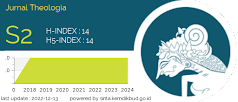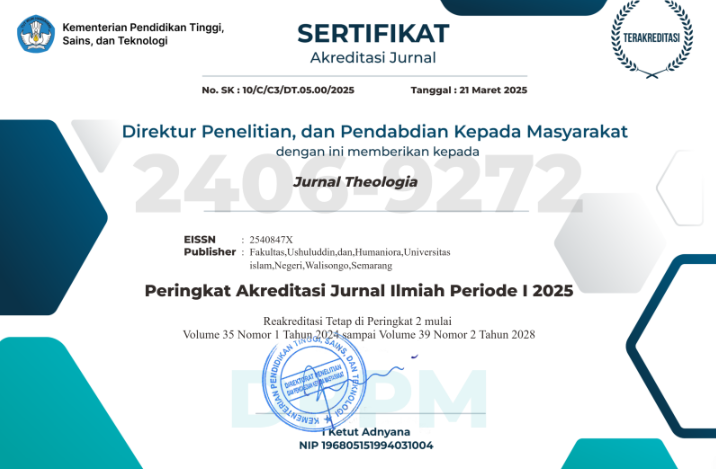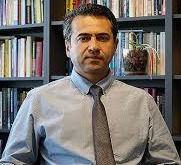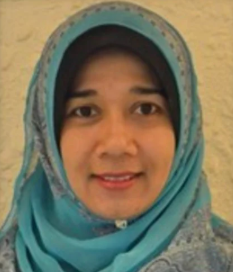PEMIKIRAN NEO-SUFISME SYAIKH AHMAD AL-MUTAMAKKIN
DOI:
https://doi.org/10.21580/teo.2018.29.2.2863Keywords:
neo-sufism, Syaikh Ahmad al-Mutamakkin, critic of religious epistemology, clericAbstract
This article intends to reveal Syaikh Ahmad al-Mutamakkin's neo-Sufism thoughts and his role in campaigning for the renewal of Islamic thought and changes in the social order of people's lives in Java in the 18th century. The discussion will focus on the domain of epistemological conflicts that legitimize al-Mutamakkin as a controversial contemporary Sufi. Historical exploration and appreciation will be more emphasized to fully look for facts about the teachings developed by al-Mutamakkin. This research is historical research using a hermeneutic approach to study and trace the artifacts of al-Mutamakkin's thoughts. This study found that al-Mutamakkin was a reformist figure who played an active role in upholding Islamic teachings as a universal religion and eternal through an eclectic and conformist approach to the existence of local wisdom values (local wisdom). As a reformist figure who carried the breath of renewal of the teachings of Sufism (neo-Sufism), al-Mutamakkin strongly criticized the teachings of Sufism developed by the Mataram elite. The king-Sufi political conception commonly adopted by the court elite in the 18th century in al-Mutamakkin's perspective was a form of betrayal of the teachings of Sufism. Therefore, in his perspective, the teachings of Sufism must be improved and adjusted to the proper khittah, namely as an instrument of self-formation and development of perfect human beings (insān kāmil) which is adjusted and guided by Allah's revelation and the Prophet's Sunnah.Downloads
References
Argawi, Kandito. Syekh Mutamakkin: Perjalanan Hidup, Pendakian Spiritual, dan Buah Pikir Emas Sang Legenda Tanah Jawa. Yogyakarta: LKIS, 2013.
Azra, Azyumardi. Jaringan Ulama Timur Tengah dan Kepulauan Nusantara Abad XVII dan XVIII (Edisi Perenial). Jakarta: Kencana, 2014.
Bizawie, Zainul Millal. Syekh Mutamakkin: Perlawanan Kultural Agama Rakyat. Jakarta: Pustaka Compass, 2014.
Choiron, A.H. “Menggali Makna Ziarah di Makam Toriqoh Syaikh Ahmad al-Mutamakkin Kajen dalam Perspektif Konseling Tasawuf.” Konseling Religi: Jurnal Bimbingan Konseling Islam 8, no. 1 (2017): 1–26. https://doi.org/10.21043/kr.v8i1.2268.
Gusmian, Islah. “Pemikiran Tasawuf Syekh Ahmad Mutamakkin: Kajian Hermeneutik atas Naskah ‘Arsy al-Muwahhidin.” Jurnal Lektur Keagamaan 11, no. 1 (2013): 57–90. https://doi.org/10.31291/JLK.V11I1.52.
Hermansyah, Hermansyah. “Neo-sufisme (Sejarah dan Prospeknya).” Khatulistiwa 3, no. 2 (2013): 113–20. https://doi.org/10.24260/khatulistiwa.v3i2.217.
Izzah el-Mahdi, Lathifatul. “Hermeneutika-Fenomenologi Paul Ricoeur: Dari Pembacaan Simbol hingga Pembacaan Teks-Aksi-Sejarah.” Hermeneia, Jurnal Kajian Islam Interdisipliner 6, no. 1 (2007): 17–42. http://digilib.uin-suka.ac.id/8508/.
Kuntowijoyo. Metodologi Sejarah. Yogyakarta: Tiara Wacana Yogya, 2003.
Margana, Sri. Pujangga Jawa dan Bayang-bayang Kolonial. Yogyakarta: Pustaka Pelajar, 2004.
Moertono, Soemarsaid. Negara dan Kekuasaan di Jawa Abad XVI-XIX. Jakarta: Gramedia, 2017.
Muslich, M. “Resolusi Konflik kasus Syaikh Al-Mutamakkin dalam Teks Kajen dan Serat Cebolek.” Al-Tahrir: Jurnal Pemikiran Islam 15, no. 1 (2015): 159–77. https://doi.org/10.21154/al-tahrir.v15i1.174.
Muzairi, Muzairi. “Pembangkangan Mistik Jawa dalam Suluk Cebolek (Episode Haji Ahmad Mutamakin).” Esensia: Jurnal Ilmu-ilmu Ushuluddin 12, no. 1 (2011): 21–38. https://doi.org/10.14421/esensia.v12i1.700.
Rahman, Fazlur. Islam. New York: The Chicago University Press, 1979.
Ricklefs, Merle Calvin. Mengislamkan Jawa: Sejarah Islamisasi di Jawa dan Penentangnya dari 1930 sampai sekarang. Jakarta: Serambi, 2013.
Ricklefs, Merle Calvin. The Seen and Unseen Worlds in Java 1726-1749: History, Literature and Islam in the Court of Pakubuwana II. Sydney: Asian Studies Association of Australia in association with Allen & Unwin and University of Hawaii Press, 1998.
Ricoeur, Paul. Hermenutika Kontemporer. Diedit oleh Josef Bleicher dan Ahmad Norma Permata. Yogyakarta: Fajar Pustaka, 2003.
Soebardi, S. Serat Cebolek: Kuasa, Agama, Pembebasan Pengadilan K. H. Al-Mutamakkin & Fenomena Syaikh Siti Jenar. Yogyakarta: Nuansa, 2004.
Soebardi, S. The Book of Cabolek a Critical Edition with Introduction, Translation, and Notes: a Contribution to the Study of the Javanese Mystical Tradition. The Hague: Martinus Nijhoff, 1975.
Syukur, H.M. Amin. Tasawuf Sosial. Yogyakarta: Pustaka Pelajar, 2004.
Wahid, K. H. Abdurrahman. “Saat Gus Dur ‘Gagal’ Bertemu Mbah Mutamakkin di Alam Kubur.” NU Online. 5 Februari, 2018. http://www.nu.or.id/post/
read/86200/saat-gus-dur-gagal-bertemu-mbah-mutamakkin-di-alam-kubur.
Wahid, K. H. Abdurrahman. “Syekh Ahmad Mutamakkin.” Republika.co.id. Agustus, 2009. https://www.republika.co.id/berita//no-channel/09/08/30/72742-syekh-ahmad-mutamakkin.
Wijaya, Manggara Bagus Satriya. “Kontribusi Syekh Ahmad Mutamakkin dalam proses Islamisasi di Jawa (Studi Kualitatif tentang Teks Kajen).” Jantra 12, no. 2 (2017): 1–17. http://www.pustaka-bpnbkalbar.org/pustaka/jantra-vol-12-no-2-desember-2017.
Woodward, R. Mark. Islam Jawa: Kesalehan Normatif Versus Kebatinan. Yogyakarta: LKiS, 1999.
Yasadipura I, Raden Ngabehi. Serat Cebolek. Jakarta: Proyek Penerbitan Buku Sastra Indonesia dan Daerah, 1981.

















